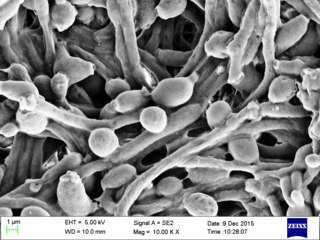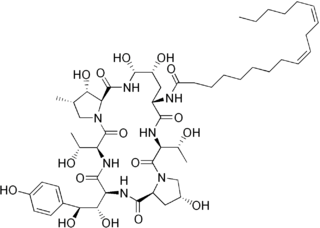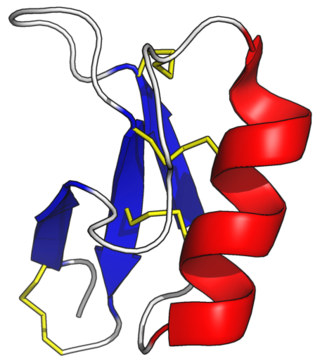Related Research Articles

The salivary glands in many vertebrates including mammals are exocrine glands that produce saliva through a system of ducts. Humans have three paired major salivary glands, as well as hundreds of minor salivary glands. Salivary glands can be classified as serous, mucous, or seromucous (mixed).

Candida albicans is an opportunistic pathogenic yeast that is a common member of the human gut flora. It can also survive outside the human body. It is detected in the gastrointestinal tract and mouth in 40–60% of healthy adults. It is usually a commensal organism, but it can become pathogenic in immunocompromised individuals under a variety of conditions. It is one of the few species of the genus Candida that cause the human infection candidiasis, which results from an overgrowth of the fungus. Candidiasis is, for example, often observed in HIV-infected patients. C. albicans is the most common fungal species isolated from biofilms either formed on (permanent) implanted medical devices or on human tissue. C. albicans, C. tropicalis, C. parapsilosis, and C. glabrata are together responsible for 50–90% of all cases of candidiasis in humans. A mortality rate of 40% has been reported for patients with systemic candidiasis due to C. albicans. By one estimate, invasive candidiasis contracted in a hospital causes 2,800 to 11,200 deaths yearly in the US. Nevertheless, these numbers may not truly reflect the true extent of damage this organism causes, given new studies indicating that C. albicans can cross the blood–brain barrier in mice.

Serine proteases are enzymes that cleave peptide bonds in proteins. Serine serves as the nucleophilic amino acid at the (enzyme's) active site. They are found ubiquitously in both eukaryotes and prokaryotes. Serine proteases fall into two broad categories based on their structure: chymotrypsin-like (trypsin-like) or subtilisin-like.

Lactoferrin (LF), also known as lactotransferrin (LTF), is a multifunctional protein of the transferrin family. Lactoferrin is a globular glycoprotein with a molecular mass of about 80 kDa that is widely represented in various secretory fluids, such as milk, saliva, tears, and nasal secretions. Lactoferrin is also present in secondary granules of PMNs and is secreted by some acinar cells. Lactoferrin can be purified from milk or produced recombinantly. Human colostrum has the highest concentration, followed by human milk, then cow milk (150 mg/L).

Fluconazole is an antifungal medication used for a number of fungal infections. This includes candidiasis, blastomycosis, coccidioidomycosis, cryptococcosis, histoplasmosis, dermatophytosis, and tinea versicolor. It is also used to prevent candidiasis in those who are at high risk such as following organ transplantation, low birth weight babies, and those with low blood neutrophil counts. It is given either by mouth or by injection into a vein.

Caspofungin is a lipopeptide antifungal drug from Merck & Co., Inc.. It is a member of a class of antifungals termed the echinocandins. It works by inhibiting the enzyme (1→3)-β-D-glucan synthase and thereby disturbing the integrity of the fungal cell wall.

Antimicrobial peptides (AMPs), also called host defence peptides (HDPs) are part of the innate immune response found among all classes of life. Fundamental differences exist between prokaryotic and eukaryotic cells that may represent targets for antimicrobial peptides. These peptides are potent, broad spectrum antimicrobials which demonstrate potential as novel therapeutic agents. Antimicrobial peptides have been demonstrated to kill Gram negative and Gram positive bacteria, enveloped viruses, fungi and even transformed or cancerous cells. Unlike the majority of conventional antibiotics it appears that antimicrobial peptides frequently destabilize biological membranes, can form transmembrane channels, and may also have the ability to enhance immunity by functioning as immunomodulators.

Anidulafungin (INN) is a semisynthetic echinocandin used as an antifungal drug. It was previously known as LY303366. It may also have application in treating invasive Aspergillus infection when used in combination with voriconazole. It is a member of the class of antifungal drugs known as the echinocandins; its mechanism of action is by inhibition of (1→3)-β-D-glucan synthase, an enzyme important to the synthesis of the fungal cell wall.

Chemokine ligand 28 (CCL28), also known as mucosae-associated epithelial chemokine (MEC), CCK1 and SCYA28, is a chemokine. CCL28 regulates the chemotaxis of cells that express the chemokine receptors CCR3 and CCR10. CCL28 is expressed by columnar epithelial cells in the gut, lung, breast and the salivary glands and drives the mucosal homing of T and B lymphocytes that express CCR10, and the migration of eosinophils expressing CCR3. This chemokine is constitutively expressed in the colon, but its levels can be increased by pro-inflammatory cytokines and certain bacterial products implying a role in effector cell recruitment to sites of epithelial injury. CCL28 has also been implicated in the migration of IgA-expressing cells to the mammary gland, salivary gland, intestine and other mucosal tissues. It has also been shown as a potential antimicrobial agent effective against certain pathogens, such as Gram negative and Gram positive bacteria and the fungus Candida albicans.

Echinocandins are a class of antifungal drugs that inhibit the synthesis of β-glucan in the fungal cell wall via noncompetitive inhibition of the enzyme 1,3-β glucan synthase. The class has been termed the "penicillin of antifungals," along with the related papulacandins, as their mechanism of action resembles that of penicillin in bacteria. β-glucans are carbohydrate polymers that are cross-linked with other fungal cell wall components, the fungal equivalent to bacterial peptidoglycan. Caspofungin, micafungin, and anidulafungin are semisynthetic echinocandin derivatives with limited clinical use due to their solubility, antifungal spectrum, and pharmacokinetic properties.

Peptide PHI, also known as peptide histidine isoleucine, is a peptide which functions as a hormone. This peptide contains a composition of 27 amino acids with histidine on the N-terminus and isoleucine on the C-terminus. It was originally isolated from the mammalian small intestine amongst mammalian neurons called intramural neurons which function in the motor activity of the intestinal walls. An example of this was revealed in a study that demonstrated that this peptide regulates water and electrolyte transportation in the human jejunum; similar to its inhibitory effects on fluid absorption in the small intestine of pigs and rats.

Beta-defensin 2 (BD-2) also known as skin-antimicrobial peptide 1 (SAP1) is a peptide that in humans is encoded by the DEFB4 gene.

Granulysin (GNLY) is a protein expressed in most mammals which functions as an antimicrobial peptide released by killer lymphocytes in cytotoxic granules. It is a pore-forming peptide, as it can puncture a microbial cell wall, allowing for other death-inducing enzymes to enter the microbe and cause microptosis. GNLY is inhibited by cholesterol, and is most effective in helping to kill cholesterol-deficient microbes.

Histatin 3, also known as HTN3, is a protein which in humans is encoded by the HTN3 gene.

Plant defensins are a family of primitive, highly stable, cysteine-rich defensins found in plants that function to defend them against pathogens and parasites. Defensins are integral components of the innate immune system and belong to the ancient superfamily of antimicrobial peptides (AMPs). AMPs are also known as host defense peptides (HDPs), and they are thought to have diverged about 1.4 billion years ago before the evolution of prokaryotes and eukaryotes. They are ubiquitous in almost all plant species, functionally diverse, and their primary structure varies significantly from one species to the next, except for a few cysteine residues, which stabilize the protein structure through disulfide bond formation. Plant defensins usually have a net positive charge due to the abundance of cationic amino acids and are generally divided into two classes. Those in the class II category contain a C-terminal pro-peptide domain of approximately 33 amino acids and are targeted to the vacuole, while the class I defensins lack this domain and mature in the cell wall. Unlike their class I counterparts, class II plant defensins are relatively smaller, and their acidic C-terminal prodomain is hypothesized to contribute to their vacuolar targeting. The first plant defensins were discovered in barley and wheat in 1990 and were initially designated as γ-thionins. In 1995, the name was changed to 'plant defensin' when it was identified that they are evolutionarily unrelated to other thionins and were more similar to defensins from insects and mammals.

Histatin-1 is a protein that in humans is encoded by the HTN1 gene.
Pathogenic fungi are fungi that cause disease in humans or other organisms. Although fungi are eukaryotic, many pathogenic fungi are microorganisms. Approximately 300 fungi are known to be pathogenic to humans; their study is called "medical mycology". Fungal infections are estimated to kill more people than either tuberculosis or malaria—about two million people per year.
Vomocytosis is the cellular process by phagocytes expel live organisms that they have engulfed without destroying the organism. Vomocytosis is one of many methods used by cells to expel internal materials into their external environment, yet it is distinct in that both the engulfed organism and host cell remain undamaged by expulsion. As engulfed organisms are released without being destroyed, vomocytosis has been hypothesized to be utilized by pathogens as an escape mechanism from the immune system. The exact mechanisms, as well as the repertoire of cells that utilize this mechanism, are currently unknown, yet interest in this unique cellular process is driving continued research with the hopes of elucidating these unknowns.
Katherine J. Franz is the chair of the department of chemistry at Duke University. She studies metal ion coordination in biological systems and looks to use the insight to manage species such as copper and iron. Franz was awarded the American Chemical Society Award for Encouraging Women into Careers in the Chemical Sciences.

Dectin-2 or C-type lectin domain containing 6A is a protein that in humans is encoded by the CLEC6A gene. Dectin-2 is a member of the C-type lectin/C-type lectin-like domain (CTL/CTLD) superfamily. The encoded protein is a type II transmembrane protein with an extracellular carbohydrate recognition domain. It functions as a pattern recognition receptor recognizing α-mannans and as such plays an important role in innate immune response to fungi. Expression is found on macrophages and dendritic cells. It can also be found at low levels in Langerhans cells and peripheral blood monocytes, where expression levels could be increased upon induction of inflammation.
References
- ↑ Histatins at the U.S. National Library of Medicine Medical Subject Headings (MeSH)
- ↑ Qin Y, Zhang L, Xu Z, Zhang J, Jiang YY, Cao Y, Yan T (July 2016). "Innate immune cell response upon Candida albicans infection". Virulence. 7 (5): 512–26. doi:10.1080/21505594.2016.1138201. PMC 5026795 . PMID 27078171.
- 1 2 Khurshid Z, Najeeb S, Mali M, Moin SF, Raza SQ, Zohaib S, Sefat F, Zafar MS (January 2017). "Histatin peptides: Pharmacological functions and their applications in dentistry". Saudi Pharmaceutical Journal. 25 (1): 25–31. doi:10.1016/j.jsps.2016.04.027. PMC 5310145 . PMID 28223859.
- ↑ Edgerton M, Jang WS (2012-01-01). "Salivary Histatins: Structure, Function, and Mechanisms of Antifungal Activity". Candida and Candidiasis, Second Edition. pp. 185–194. doi:10.1128/9781555817176.ch13. ISBN 978-1-55581-539-4.
- ↑ Kavanagh K, Dowd S (March 2004). "Histatins: antimicrobial peptides with therapeutic potential" (PDF). The Journal of Pharmacy and Pharmacology. 56 (3): 285–9. doi: 10.1211/0022357022971 . PMID 15025852.
- ↑ Oudhoff MJ, Bolscher JG, Nazmi K, Kalay H, van 't Hof W, Amerongen AV, Veerman EC (November 2008). "Histatins are the major wound-closure stimulating factors in human saliva as identified in a cell culture assay". FASEB Journal. 22 (11): 3805–12. doi: 10.1096/fj.08-112003 . PMID 18650243. S2CID 19797007.
- 1 2 Oppenheim FG, Xu T, McMillian FM, Levitz SM, Diamond RD, Offner GD, Troxler RF (June 1988). "Histatins, a novel family of histidine-rich proteins in human parotid secretion. Isolation, characterization, primary structure, and fungistatic effects on Candida albicans". The Journal of Biological Chemistry. 263 (16): 7472–7. doi: 10.1016/S0021-9258(18)68522-9 . PMID 3286634.
- ↑ Piludu M, Lantini MS, Cossu M, Piras M, Oppenheim FG, Helmerhorst EJ, Siqueira W, Hand AR (November 2006). "Salivary histatins in human deep posterior lingual glands (of von Ebner)". Archives of Oral Biology. 51 (11): 967–73. doi:10.1016/j.archoralbio.2006.05.011. PMID 16859632.
- ↑ Khurshid Z, Najeeb S, Mali M, Moin SF, Raza SQ, Zohaib S, Sefat F, Zafar MS (January 2017). "Histatin peptides: Pharmacological functions and their applications in dentistry". Saudi Pharmaceutical Journal. 25 (1): 25–31. doi:10.1016/j.jsps.2016.04.027. PMC 5310145 . PMID 28223859.
- ↑ Swidergall M, Ernst JF (August 2014). "Interplay between Candida albicans and the Antimicrobial Peptide Armory". Eukaryotic Cell. 13 (8): 950–957. doi:10.1128/EC.00093-14. PMC 4135787 . PMID 24951441.
- ↑ Tsai H, Bobek LA (October 1997). "Human salivary histatin-5 exerts potent fungicidal activity against Cryptococcus neoformans". Biochimica et Biophysica Acta (BBA) - General Subjects. 1336 (3): 367–9. doi:10.1016/S0304-4165(97)00076-7. PMID 9367163.
- ↑ Shimada T (June 2006). "Salivary proteins as a defense against dietary tannins". Journal of Chemical Ecology. 32 (6): 1149–63. Bibcode:2006JCEco..32.1149S. doi:10.1007/s10886-006-9077-0. PMID 16770710. S2CID 21617545.